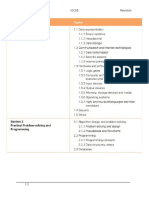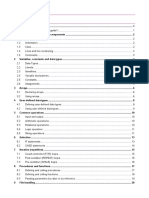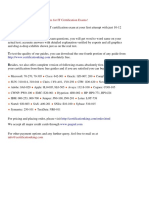7.7 Identifying Errors in Algorithms
Uploaded by
Anisha Bushra Akond7.7 Identifying Errors in Algorithms
Uploaded by
Anisha Bushra AkondIdentifying errors in algorithms
Objectives: Student should be able to -
identify and correct errors in:
flowcharts
programs
pseudocode
Q1. A piece of pseudocode was written to input ten numbers and then calculate
and output the largest and average value of the input data.
1 Largest = 0
2 Sum = 0
3 FOR X = 0 TO 10
4 INPUT X
5 IF X > Largest THEN X = Largest
6 OUTPUT Largest
7 Sum = Sum + X
8 NEXT X
9 Average = Sum * 10
10 OUTPUT Average
There are four errors in this algorithm. Locate these errors and suggest a
correction.
Error 1: Line 40: INPUT X is using the same counter variable of FOR-NEXT loop
Correction: Change the counter variable of FOR-NEXT loop.
For example - FOR Count = 1 TO 10
Error 2: Line 50: X = Largest
Correction: It should be, Largest = X
Error 3: Line 60: Output should not be inside the loop.
Correction: It should be outside the loop.
For example - 85 OUTPUT Largest
Error 4: Line 90: Incorrect formula for calculation of average.
CS 2210/ 0478 Page 1 of 8
Correction: It should be - Average = Sum/10
Q2. Read this section of program code that should input 50 numbers and then output the
average.
1 Total = 0
2 FOR Counter = 1 TO 50
3 INPUT Num
4 Total = Total + 1
5 Counter = Counter + 1
6 Average = Total/Counter
7 NEXT Counter
8 PRINT Average
There are four errors in this code.
Locate these errors and suggest code corrections to remove each error. Error 1:
Line 4: Total = Total + 1
Correction: It should be, Total = Total + Num
Error 2: Line 5: Counter = Counter + 1
Correction: It should be removed because the counter variable's value increments
by 1, automatically in FOR-NEXT loop.
Error 3: Line 6: Average = Total/Counter
Correction: It should be outside the loop. Swap line 6 and 7.
Error 4: Line 6: Average = Total/Counter
Correction: Incorrect formula for calculation of average.
It should be - Average = Total/50
CS 2210/ 0478 Page 2 of 8
Q3. An algorithm has been written in pseudocode to input some numbers. It only outputs
any numbers that are greater than or equal to 100. The number 999 is not output and stops
the algorithm.
INPUT Number
WHILE Numbers < > 999 DO IF
Number > 100
THEN
OUTPUT Number
ENDI
F
ENDWHIL
E
OUTPUT Number
a) Identify the four errors in the pseudocode and suggest corrections.
Error 1: WHILE Numbers < > 999 DO
Correction: Numbers should be Number. It should be -
WHILE Number < > 999 DO
Error 2: IF Number > 100
Correction: It should be, IF Number >= 100
Error 3: INPUT Number is missing from inside the loop.
Correction: Insert INPUT Number after the ENDIF statement.
Error 4: The final OUTPUT Number outside the loop is not needed.
Correction: Remove it.
CS 2210/ 0478 Page 3 of 8
b) Write a pseudocode statement to change the corrected algorithm to output all
numbers between 100 and 200 inclusive.
You do not need to rewrite the whole algorithm.
IF Number >= 100 AND Number < = 200
Q4. An algorithm allows a user to input their password and checks that there are at least
eight characters in the password. Then, the user is asked to re-input the password to check
that both inputs are the same. The user is allowed three attempts at inputting a password of
the correct length and a matching pair of passwords.
The pre-defined function LEN(X) returns the number of characters in the string, X. 01
Attempt ‹— 0
02 REPEAT
03 PassCheck ‹— TRUE
04 OUTPUT "Please enter your password "
05 INPUT Password
06 IF LEN(Password) < 8
07 THEN
08 PassCheck ‹— TRUE
09 ELSE
10 OUTPUT "Please re-enter your password "
11 INPUT Password2
12 IF Password < > Password
13 THEN
14 PassCheck ‹— FALSE
15 ENDIF
16 ENDIF
17 Attempt ‹— Attempt + 1
18 UNTIL PassCheck OR Attempt < > 3
19 IF PassCheck
20 THEN
21 OUTPUT "Password success"
22 ELSE
23 OUTPUT "Password fail"
24 ENDIF
CS 2210/ 0478 Page 4 of 8
a) Identify the three errors in the pseudocode and suggest a correction to remove
each error.
Error 1: Line 8: PassCheck ‹— TRUE
Correction: It should be, PassCheck ‹— FALSE
Error 2: Line 12: IF Password < > Password Correction: It
should be, IF Password < > Password2 Error 3: Line 18:
UNTIL PassCheck OR Attempt < > 3
Correction: It should be, UNTIL PassCheck OR Attempt = 3
b) The algorithm includes two types of check on the data input.
Identify and describe each type of check.
Type of check 1: Length check validation.
Description: Checks number of characters in password.
Type of check 1: Double entry verification check.
Description: Ask to input the password twice and compares both to check if they are
same.
c) Give two sets of test data for this algorithm and a reason for choosing each set.
Each set of test data and its reason must be different.
Set 1: ALk#24
Reason: Abnormal data, it should be rejected because it contains characters less than 8.
Set 2: John@7351, John@7351
Reason: Normal data, it should be accepted because it contains characters not less than 8 and
both are same.
CS 2210/ 0478 Page 5 of 8
Q5. An algorithm has been written in pseudocode to generate 50 positive random integers
with values less than or equal to 100. These numbers are stored in the array NumRand[ ]
The function RANDOM(X, Y) generates a random integer greater than X and less than or equal
to Y. For example, RANDOM(1, 4) generates 2 or 3 or 4
01 Count ‹— 0
02 WHILE Counter > 50 DO
03 NumRand[Counter] ‹— RANDOM(1, 100)
04 Counter ‹— Counter - 2
05 ENDWHILE
Find the four errors in the pseudocode and write a correction for each error. Error 1:
Line 01: Count ‹— 0
Correction: It should be, Counter ‹— 0
Error 2: Line 02: WHILE Counter > 50 DO
Correction: It should be, WHILE Counter < 50 DO
Error 3: Line 03: NumRand[Counter] ‹— RANDOM(1, 100) Correction:
It should be, NumRand[Counter] ‹— RANDOM(0, 100) Error
4: Line 04: Counter ‹— Counter - 2
Correction: It should be, Counter ‹— Counter + 1
CS 2210/ 0478 Page 6 of 8
Q6. The pseudocode algorithm should work as a calculator and output the result.
01 Continue ‹— 1
02 WHILE Continue = 0
03 OUTPUT "Enter 1 for +, 2 for -, 3 for *, or 4 for /"
04 INPUT Operator
05 OUTPUT "Enter the first value"
06 INPUT Value1
07 OUTPUT "Enter the second value"
08 OUTPUT Value2
09 #IF Operator
10 1 : Answer ‹— Value1 + Value2
11 2 : Answer ‹— Value1 - Value2
12 3 : Answer ‹— Value1 * Value2
13 4 : Answer ‹— Value1 / Value2
14 ENDCASE
15 OUTPUT "The answer is ", Value1
16 OUTPUT "Do you wish to enter more values (Yes or No)?"
17 INPUT MoreValues
18 IF MoreValues = "No"
19 THEN
20 Continue ‹— 1
21 ENDIF
22 UNTIL Continue = 0
Find the five errors in the pseudocode and suggest a correction for each error. Error 1:
Line 01: Continue ‹— 1
Correction: It should be, Continue ‹— 0
Error 2: Line 22: UNTIL Continue = 0
Correction: It should be, ENDWHILE
Error 3: Line 08: OUTPUT Value2
Correction: It should be, INPUT Value2
Error 4: Line 09: IF Operator
Correction: It should be, CASE OF Operator
CS 2210/ 0478 Page 7 of 8
Error 5: Line 15: OUTPUT "The answer is ", Value1
Correction: It should be, OUTPUT "The answer is ", Answer
/ OR /
Error 1: Line 02: WHILE Continue = 0
Correction: It should be, REPEAT
Error 2: Line 20: Continue ‹— 1
Correction: It should be, Continue ‹— 0
Error 3: Line 22: UNTIL Continue = 0 Correction:
It should be, UNTIL Continue = 1
Error 4: Line 08: OUTPUT Value2
Correction: It should be, INPUT Value2
Error 5: Line 09: IF Operator
Correction: It should be, CASE OF Operator
Error 6: Line 15: OUTPUT "The answer is ", Value1
Correction: It should be, OUTPUT "The answer is ", Answer
CS 2210/ 0478 Page 8 of 8
You might also like
- Igcse Computer Science Revision Mind Map - Data ReperssentingNo ratings yetIgcse Computer Science Revision Mind Map - Data Reperssenting1 page
- IT For Cambridge International As A Level Coursebook (Paul Long, Sarah Lawrey, Victoria Ellis) - 2022 OnwardsNo ratings yetIT For Cambridge International As A Level Coursebook (Paul Long, Sarah Lawrey, Victoria Ellis) - 2022 Onwards573 pages
- Grade Thresholds - June 2023: Cambridge IGCSE Computer Science (0478)No ratings yetGrade Thresholds - June 2023: Cambridge IGCSE Computer Science (0478)1 page
- Unit 2: Creating Systems To Manage InformationNo ratings yetUnit 2: Creating Systems To Manage Information10 pages
- GCSE L1 L2 Computer Science 2020 Sample Assessment Materials For Paper 1No ratings yetGCSE L1 L2 Computer Science 2020 Sample Assessment Materials For Paper 132 pages
- A2 LEVEL - Computer Science - 9618 - CAIE - SYLLABUSNo ratings yetA2 LEVEL - Computer Science - 9618 - CAIE - SYLLABUS93 pages
- IGCSE CS 0478 Paper 1 and 2 Revision Exams For 2024 and Bonus Past Exams Data Analysis For All Paper 1 2023No ratings yetIGCSE CS 0478 Paper 1 and 2 Revision Exams For 2024 and Bonus Past Exams Data Analysis For All Paper 1 202368 pages
- 4cp0-01-June-2021 EDEXCEL IGCSE COMPUTER SCIENCE - Paper1No ratings yet4cp0-01-June-2021 EDEXCEL IGCSE COMPUTER SCIENCE - Paper128 pages
- Oxfordaqa Advance Info 9210 International Gcse Computer Science May June 2022No ratings yetOxfordaqa Advance Info 9210 International Gcse Computer Science May June 20225 pages
- 5054-space-physics-practice-questions-for-examination-from-2023-1No ratings yet5054-space-physics-practice-questions-for-examination-from-2023-125 pages
- Chapter 7 - Section 7.1 To 7.3 (Autosaved)No ratings yetChapter 7 - Section 7.1 To 7.3 (Autosaved)67 pages
- 2021 - 19 The Bigger Picture CS Edexcel IGCSENo ratings yet2021 - 19 The Bigger Picture CS Edexcel IGCSE10 pages
- 1.3 Hardware N Software Workbook by Inqilab PatelNo ratings yet1.3 Hardware N Software Workbook by Inqilab Patel109 pages
- OL P2 2210 Guess Paper (May 2023) by BandeshahNo ratings yetOL P2 2210 Guess Paper (May 2023) by Bandeshah177 pages
- Cambridge International AS & A Level: Computer Science 9618/42No ratings yetCambridge International AS & A Level: Computer Science 9618/4216 pages
- Chapter 14: Programming and Data Representation: Answers To Coursebook Questions and TasksNo ratings yetChapter 14: Programming and Data Representation: Answers To Coursebook Questions and Tasks50 pages
- Cambridge IGCSE™: Additional Mathematics 0606/22 October/November 2020No ratings yetCambridge IGCSE™: Additional Mathematics 0606/22 October/November 20208 pages
- Cambridge International AS & A Level: Computer Science 9618/22No ratings yetCambridge International AS & A Level: Computer Science 9618/2294 pages
- KS3 Answer Sheet - 01 Introduction To ComputersNo ratings yetKS3 Answer Sheet - 01 Introduction To Computers7 pages
- O Level Computer Studies - Practice Questions For Cie Exams 2013100% (3)O Level Computer Studies - Practice Questions For Cie Exams 201341 pages
- Caie As Computer Science 9618 Practical Notes and GuideNo ratings yetCaie As Computer Science 9618 Practical Notes and Guide8 pages
- Unit 12 Algorithm Design & Problem-SolvingNo ratings yetUnit 12 Algorithm Design & Problem-Solving12 pages
- Final: 9702/42 A Level Physics - Mark Scheme March 2022No ratings yetFinal: 9702/42 A Level Physics - Mark Scheme March 202225 pages
- 11.4 Communicable Diseases Disease Prevention and the Immune System Qp a Level Ocr BiologyNo ratings yet11.4 Communicable Diseases Disease Prevention and the Immune System Qp a Level Ocr Biology14 pages
- CIE IGCSE 0580 2019 Hardest Questions Compilation 2No ratings yetCIE IGCSE 0580 2019 Hardest Questions Compilation 269 pages
- CIE IGCSE 0580 MATHEMATICS WS Transformations-FinishedNo ratings yetCIE IGCSE 0580 MATHEMATICS WS Transformations-Finished11 pages
- Specimen 2023 QP - Paper 2 CIE Physics IGCSENo ratings yetSpecimen 2023 QP - Paper 2 CIE Physics IGCSE14 pages
- 7.6 Test Data and Trace Tables To Document Dry Runs of AlgorithmsNo ratings yet7.6 Test Data and Trace Tables To Document Dry Runs of Algorithms5 pages
- Chapter 26 - Cleanroom Software EngineeringNo ratings yetChapter 26 - Cleanroom Software Engineering3 pages
- Evaluating E-Commerce Website Content Management System in Assisting Usability IssuesNo ratings yetEvaluating E-Commerce Website Content Management System in Assisting Usability Issues6 pages
- Maharana Pratap College of Technology &management: A Seminar On Java Servlet & AppletNo ratings yetMaharana Pratap College of Technology &management: A Seminar On Java Servlet & Applet20 pages
- Software Quality Standards - ISO25010 - CAPSTONE PROJECT 2100% (2)Software Quality Standards - ISO25010 - CAPSTONE PROJECT 220 pages
- sapnote-205528_Report painter_ILLEGAL_SIGN_FORMATNo ratings yetsapnote-205528_Report painter_ILLEGAL_SIGN_FORMAT2 pages
- Binary Code Obfuscation Through C++ Template MetaprogrammingNo ratings yetBinary Code Obfuscation Through C++ Template Metaprogramming12 pages
- Lecture 01 - Getting Started, Compilation, Execution, Byte Code, Machine Code, JDK, JRE, JVM, JITNo ratings yetLecture 01 - Getting Started, Compilation, Execution, Byte Code, Machine Code, JDK, JRE, JVM, JIT3 pages
- Digital Design With an Introduction to the Verilog HDL VHDL and SystemVerilog 6th Edition Mano Solutions Manual - Full Version With All Chapters Is Ready For Download100% (3)Digital Design With an Introduction to the Verilog HDL VHDL and SystemVerilog 6th Edition Mano Solutions Manual - Full Version With All Chapters Is Ready For Download34 pages
- Difference Between PFILE and SPFILE in OracleNo ratings yetDifference Between PFILE and SPFILE in Oracle3 pages
- Java Programming: II B.SC., Computer ScienceNo ratings yetJava Programming: II B.SC., Computer Science39 pages
- Instant Download (Ebook) Introducing the MySQL 8 Document Store by Charles Bell ISBN 9781484227244, 1484227247 PDF All Chapters100% (8)Instant Download (Ebook) Introducing the MySQL 8 Document Store by Charles Bell ISBN 9781484227244, 1484227247 PDF All Chapters55 pages
- Igcse Computer Science Revision Mind Map - Data ReperssentingIgcse Computer Science Revision Mind Map - Data Reperssenting
- IT For Cambridge International As A Level Coursebook (Paul Long, Sarah Lawrey, Victoria Ellis) - 2022 OnwardsIT For Cambridge International As A Level Coursebook (Paul Long, Sarah Lawrey, Victoria Ellis) - 2022 Onwards
- Grade Thresholds - June 2023: Cambridge IGCSE Computer Science (0478)Grade Thresholds - June 2023: Cambridge IGCSE Computer Science (0478)
- GCSE L1 L2 Computer Science 2020 Sample Assessment Materials For Paper 1GCSE L1 L2 Computer Science 2020 Sample Assessment Materials For Paper 1
- A2 LEVEL - Computer Science - 9618 - CAIE - SYLLABUSA2 LEVEL - Computer Science - 9618 - CAIE - SYLLABUS
- IGCSE CS 0478 Paper 1 and 2 Revision Exams For 2024 and Bonus Past Exams Data Analysis For All Paper 1 2023IGCSE CS 0478 Paper 1 and 2 Revision Exams For 2024 and Bonus Past Exams Data Analysis For All Paper 1 2023
- 4cp0-01-June-2021 EDEXCEL IGCSE COMPUTER SCIENCE - Paper14cp0-01-June-2021 EDEXCEL IGCSE COMPUTER SCIENCE - Paper1
- Oxfordaqa Advance Info 9210 International Gcse Computer Science May June 2022Oxfordaqa Advance Info 9210 International Gcse Computer Science May June 2022
- 5054-space-physics-practice-questions-for-examination-from-2023-15054-space-physics-practice-questions-for-examination-from-2023-1
- Cambridge International AS & A Level: Computer Science 9618/42Cambridge International AS & A Level: Computer Science 9618/42
- Chapter 14: Programming and Data Representation: Answers To Coursebook Questions and TasksChapter 14: Programming and Data Representation: Answers To Coursebook Questions and Tasks
- Cambridge IGCSE™: Additional Mathematics 0606/22 October/November 2020Cambridge IGCSE™: Additional Mathematics 0606/22 October/November 2020
- Cambridge International AS & A Level: Computer Science 9618/22Cambridge International AS & A Level: Computer Science 9618/22
- O Level Computer Studies - Practice Questions For Cie Exams 2013O Level Computer Studies - Practice Questions For Cie Exams 2013
- Caie As Computer Science 9618 Practical Notes and GuideCaie As Computer Science 9618 Practical Notes and Guide
- Final: 9702/42 A Level Physics - Mark Scheme March 2022Final: 9702/42 A Level Physics - Mark Scheme March 2022
- 11.4 Communicable Diseases Disease Prevention and the Immune System Qp a Level Ocr Biology11.4 Communicable Diseases Disease Prevention and the Immune System Qp a Level Ocr Biology
- CIE IGCSE 0580 2019 Hardest Questions Compilation 2CIE IGCSE 0580 2019 Hardest Questions Compilation 2
- CIE IGCSE 0580 MATHEMATICS WS Transformations-FinishedCIE IGCSE 0580 MATHEMATICS WS Transformations-Finished
- 7.6 Test Data and Trace Tables To Document Dry Runs of Algorithms7.6 Test Data and Trace Tables To Document Dry Runs of Algorithms
- Evaluating E-Commerce Website Content Management System in Assisting Usability IssuesEvaluating E-Commerce Website Content Management System in Assisting Usability Issues
- Maharana Pratap College of Technology &management: A Seminar On Java Servlet & AppletMaharana Pratap College of Technology &management: A Seminar On Java Servlet & Applet
- Software Quality Standards - ISO25010 - CAPSTONE PROJECT 2Software Quality Standards - ISO25010 - CAPSTONE PROJECT 2
- Binary Code Obfuscation Through C++ Template MetaprogrammingBinary Code Obfuscation Through C++ Template Metaprogramming
- Lecture 01 - Getting Started, Compilation, Execution, Byte Code, Machine Code, JDK, JRE, JVM, JITLecture 01 - Getting Started, Compilation, Execution, Byte Code, Machine Code, JDK, JRE, JVM, JIT
- Digital Design With an Introduction to the Verilog HDL VHDL and SystemVerilog 6th Edition Mano Solutions Manual - Full Version With All Chapters Is Ready For DownloadDigital Design With an Introduction to the Verilog HDL VHDL and SystemVerilog 6th Edition Mano Solutions Manual - Full Version With All Chapters Is Ready For Download
- Instant Download (Ebook) Introducing the MySQL 8 Document Store by Charles Bell ISBN 9781484227244, 1484227247 PDF All ChaptersInstant Download (Ebook) Introducing the MySQL 8 Document Store by Charles Bell ISBN 9781484227244, 1484227247 PDF All Chapters








































































































